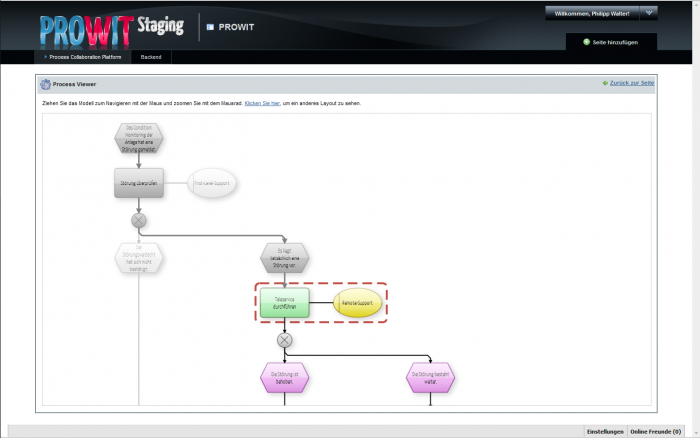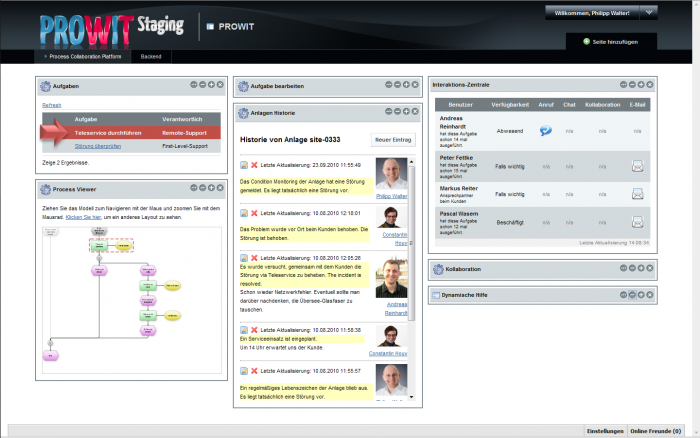
What is "Web 2.0" actually? Obviously Web 2.0 is about doing things together online, with every participant both consuming and producing content. Many success stories entwine around Web 2.0: not only huge projects like Wikipedia show that the principle of self-organization works and scales well, even with very many independent participants, as long as the common work topic is neatly defined and the tools are intuitive. Their success is often attributed to "collective intelligence", with anthills, beehives and shoals in mind, where "the whole becomes more than the sum of its parts". It's a kind of magic that is actually so intriguing that there are efforts to merge Web 2.0 with BPM, with namings like "Social BPM" or "Enterprise 2.0".
But what can users expect from or achieve with such concepts? In the joint research project PROWIT funded by the German Ministry of Research and Education (BMBF), we take a look into the future. Within a research consortium we are developing a next-generation "Human Centric BPM" solution that integrates new communication services with business software through a central process collaboration platform. Have a look at the screenshots attached below to get an impression.
There is already a number of Social BPM solutions, so what makes PROWIT different and innovative? Well, one aspect is that we want to include every employee directly in the whole process lifecycle instead of limiting him to process execution - even if he doesn't know how to read or modify business process models. We think that's an essential aspect and that's why we call our concept "Human Centric BPM". To give an example, think of the internet around the millennium change: theoretically it was always possible for everyone to create and offer content. But what fraction of internet users was really able to create HTML content? Very few! And what did they produce mostly? Tons of private homepages, most of them rather being technology studies of colorful bullets and <blink>-tags than really relevant content!
Nowadays - and that's the main connotation of "Web 2.0" - we have lightweight, interactive, modern, ubiquitous solutions answering our purposes out of the cloud. For the first time, the majority of internet users is really enabled to produce content, not theoretically. Moreover, every bit of content has its place: wikis for knowledge, blogs for articles and discussions, streaming sites for videos, social networks for friends and families. Focussing specific ends in this way differentiates Web 2.0 from Web 1.x. Hosting offers are no longer restricted to storage and bandwidth: Web 2.0 platforms include functionality that matches the hosted content, e.g. by offering previews, search functions, tagging, recommendations, feedback and discussion channels, linking content in search engines etc. "Web 2.0", that is actually "everyone can participate and contribute, without the need for special skills". And that's the kind of Web 2.0 that we want to have in PROWIT to create a truly Human Centric BPM solution.
Currently we are researching novel approaches how to salvage collective BPM knowledge and how to use it to help employees work more productively and organizations to become more efficient. And since Web 2.0 is about collective intelligence and collaboration, we are interested in your feedback, too. We believe that discussing ideas is of utmost importance, indispensable for growing them to success. So please have a look at the screenshots and tell us what you think. And stay tuned, of course, for further news about PROWIT!
Update: the originally attached screenshots were automatically scaled down to unreadability, so here are bigger and annotated versions.
Fig. 1: Users access the PROWIT prototype through a process collaboration portal. The exemplary application scenario is centered around a technical customer service process. Platform users can pick tasks from their task list (top left) and immediately see where it is located in the overall process (bottom left). While working on their task (top center) they can collaborate with other users directly (right column) or by reading and writing documentation (bottom center and bottom right, partially visible).
Fig. 2: The process model is steplessly zoomable and scrollable and visualizes where the current task is located (dashed red frame), which preceding tasks were already finished (dark grey) or skipped (light grey) and which process parts still follow the current task.
Fig. 3: All task-specific information about a process instance is shown in the center portlet. In its lower part the process flow can be controlled by taking decisions and feeding them back into the system using a task form. People that are associated with the task or the process are shown in a dynamic contact list on the right.
Fig. 4: The platform is extensible with standardized modules that can provide additional information and/or functionality. For example, the center column shows a "technical site history" module that automatically documents all tasks conducted with respect to the installation addressed in the current process.




.png)











